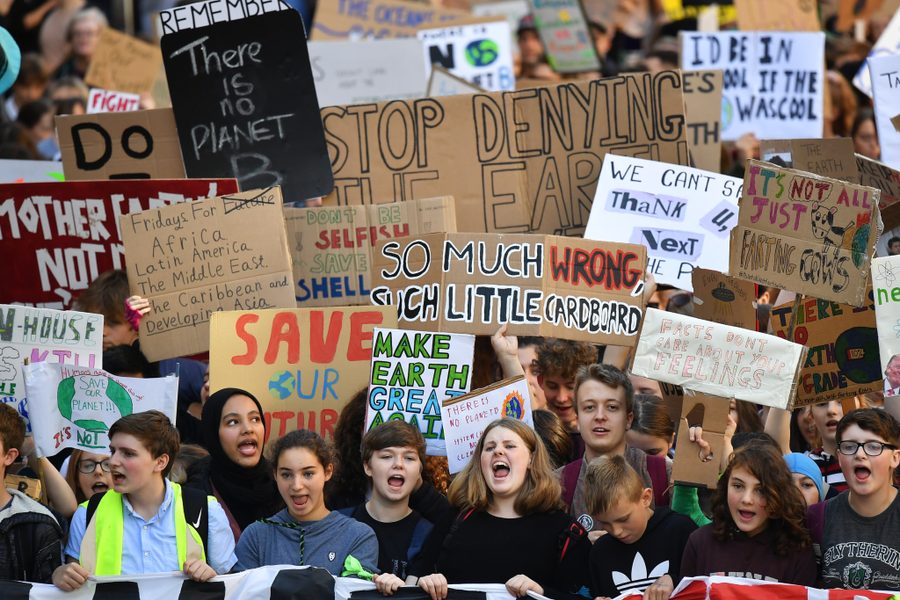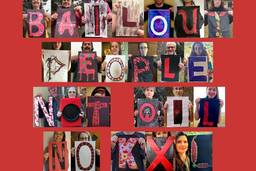As Oil Plummets, Climate Activists Say Now Is the Time to Mobilize for a Green New Deal
Earth Day is more important now than ever. Here’s how the climate movement is getting organized.
Christine MacDonald

The 50th anniversary of Earth Day is Wednesday, taking place in the very same week demand for oil cratered so badly that prices nosedived until they were briefly trading in negative numbers. In normal times, these two colliding historic events would be reason for climate activists to rejoice. But these are COVID times. And, while this week’s events are prompting plenty of reflection, the future seems riskier and less certain than ever.
Some supporters of a Green New Deal say with oil prices so low, now would be a great time to nationalize oil, end drilling and rebuild a stronger economy fueled by clean and renewable energy. “This moment is a perfect example of the need to loudly agitate for nationalization of the oil industry with a permanent majority equity stake for the explicit political purpose of unwinding it as rapidly as possible,” said Sean Estelle, a National Political Committee member of Democratic Socialists of America. “It’s never been a better moment to crush a poisonous and destructive industry that has hurtled us into a huge climate crisis, and instead invest in a green economy and retraining for all workers that would be affected by this shift.”
On the one hand, President Trump, who has denied the existence of climate change, has used the pandemic to roll back environmental law and push ahead with unpopular pipeline construction in an attempt to lock the country into the climate-changing fossil fuel economy for decades to come. Fellow Republican and friend of Big Oil, Senate Majority Leader Mitch McConnell (R-Ky.), meanwhile, blocked even the modest renewable energy stimulus the Democrats sought to include in last month’s $2 trillion bailout, while both parties’ lawmakers saw fit to send billions of dollars to large corporations with relatively few strings attached.
Even as the oil industry fights to keep its stranglehold on our future, the last two years have seen an unprecedented surge in climate activism, leading to the Green New Deal, a proposed way out of the climate crisis that would put environmental justice at the forefront of adaptation, ensuring healthcare for all, strong labor and union protections, and good jobs in the new economy to replace ones that disappear as fossil fuels and other polluting industries give way to a new green economy. Now, as the COVID-19 pandemic has provided a preview of how climate change is expected to create similar disruptions to supply chains and how social safety nets will fail, environmental justice activists have countered with the People’s Bailout and Green Stimulus. Both propose addressing pandemic’s economic fallout by supporting working people, rather than giving away billions more to corporations.
But if COVID-19 has laid bare inequities that climate change will only stoke, a considerable challenge is figuring out how to convince a divided and overwhelmed public of the very real risks of putting off climate action this year, at a time when scientists say we have less than a decade left to bring down emissions and head of dangerous natural tipping points. “We don’t have much time at all,” Bill McKibben, the author and cofounder of 350.org, said. “We probably shouldn’t just forego one of those years.”
With so many people seriously ill and others out of work and worried about paying the rent while the economy languishes in a recession, climate activists have exchanged street protests for three days of Earth Day Live online activities, starting Wednesday. The star-studded rally and concert, which will be captured via livestream, will include panel discussions, teach-ins and poetry readings. The first Earth Day in 1970 brought 20 million Americans into the streets to demand environmental protections that led federal laws that clean up U.S. rivers and harbors, crack down on industrial polluters and protect endangered species — many of the same laws that Trump has targeted for removal since taking office. The Earth Day Network, with a mission to “diversify, educate and activate the environmental movement worldwide,” has been convening the global environmental day ever since. In recent decades the enormous affair with activities in more than 190 countries has come under criticism for being captured by its corporate sponsors, a fact that today’s edgier youth climate flank of the movement has been intent on changing.
Organizers hope to attract more people to the climate movement, even as they worry that online agitating is a tepid replacement for massive street protest. “It does feel much harder to galvanize people to take action because there is just inherently less collective power in joining a mass livestream than joining thousands of people in the streets,” said Naina Agrawal-Hardin, a 17-year-old high school junior from Ann Arbor and an organizer with the Sunrise Movement.
But “people are really struggling to get food on the table or they just lost their job. That’s a very different circumstance than business as usual. So it’s been tough” to adapt Earth Day plans to today’s pandemic realities, she said. “How can we not be tone deaf and really lean into a narrative that encompasses both the pain people are feeling right now and the imminent looming climate crisis?”
Local groups have embarked in similar online pivots. In the San Francisco Bay area, the environmental justice organization Youth Vs. Apocalypse was also forced to scrap its original Earth Day plans to mobilize even more than the 40,000 people who took to San Francisco’s streets last September for the global climate strike. After long hours of coalition building, determining the march route and applying for permits, 15-year-old activist Sarah Goody recalls the sense of dejection she and her fellow organizers felt one evening last month when they realized they were going to have to call the whole thing off, because there could be no street protests in a pandemic. “That was hard but after sitting with it for a few days,” Goody says, “the amount of incredible ideas (for moving the protests online) was really inspiring.”
Like Sunrise and other groups, Goody’s organization is also using pandemic Earth Day to build their organizations internally and reach out to frontline communities, seeking to broaden their coalition by drawing parallels to between the economic and social fallout of coronavirus crisis and climate change.
“In this pandemic we are seeing the government bailing out big companies instead of poor people and the middleclass. We feel that the climate crisis — and also coronavirus — disproportionately affects communities of color and lower class. And the big oil industry and corporations treat migrant communities, indigenous communities, and communities of color and lower class as if they were disposable,” said Goody, whose organization runs environmental justice clubs at 10 Bay Area schools.
Solidarity is taking on a whole new meaning this year — albeit online. Activists and organizations are finding ways to comfort people, share information and resources, train new activists, and push progressive solutions to both crises, while mutual aid efforts have grown. The Indigenous Environmental Network has launched a Covid-19 Mutual Aid Fund for struggling organizers and organizations right now. Goody’s group has launched its own local mutual aid effort using social networks and will use social media challenges during the three-day digital action to continue its campaigns targeting fossil fuel companies and their investors using hashtags such as #NoOneIsDisposable.
In the Chicagoland area, meanwhile, a coalition of unions, immigrant rights organizations and community groups was already planning Earth Day to May Day, a series of protests and other street actions fighting for economic rights and the environment. They had been expecting an even bigger turnout this year, when the pandemic outbreak forced organizers to move the protests online. Between these two “social justice holidays,” the 67 organizations, which include workers’ centers, immigrant rights groups, and mainline environmental organizations like the Sierra Club, will continue to their push for solutions that prioritize working people and the planet over corporations, and hold politicians accountable — two goals that have emerged as a unifying mantra of many of this year’s Earth Day events.
While online activism may not create the same results as street mobilizations, there are some upsides, according to Roberto Jesus Clack, associate director of the Joliet, Ill.-based Warehouse Workers for Justice, part of the Earth Day to May Day Coalition.
“It can be pretty easy to build an audience quickly through online organizing,” said Clack, whose center works at Amazon, Walmart and other warehouses in the Chicagoland area. “A lot of the time, it would take sending a TV crew or something like that. Now you just have to hit a link or two and you can hear about an issue.”
With warehouses considered essential to keeping the country’s supply chains running, Clack said he and his coworkers have been busy supporting warehouse workers, including some who have gone on strike in recent weeks to protest unsafe working conditions. Typically it takes numerous face-to-face conversations to organize a workplace.
But with many essential workers fearfully heading into workplaces without face masks, health coverage, or paid leave if they get sick, and so many others furloughed or laid off and sitting at home with time on their hands, Clack said, organizing can go more quickly. After all, life or death matters are on the line and so many working people are fired up, he said. But he worries the most vulnerable are being left out. “There’s definitely a portion of the movement (without good Internet access) that we’re missing out on right now. It’s going to be extremely difficult,” he said. “There are serious ways that (the pandemic) obstructs us from organizing.”
The Earth Day to May Day actions grew out of earlier alliances between people-centered and environment-centered groups, such as their coalition to block the controversial NorthPoint Development business park project that the Joliet mayor and City Council voted to push forward last week, even as opponents charged them with using the pandemic to overrule public dissent.
“We see the same corporate actors that really drive down workplace standards are also contributing hugely to climate change,” he said. “We have problems with the same people and we have to come together” right now, said Clack, who compares today’s pandemic-induced economic troubles to the 2008 financial crisis that gave way to, among other things, Occupy Wall Street. He’s upbeat on what this will mean for future protests.
“It’s unclear when we’ll be able to hit the streets again,” he said, “but I think that the movement we see emerge is going to be pretty unprecedented.”
Christine MacDonald is an investigative reporter and author, whose work focuses climate change, environmental sustainability and greenwashing. She was a 2019-2020 fellow with the Leonard C. Goodman Institute for Investigative Reporting.








